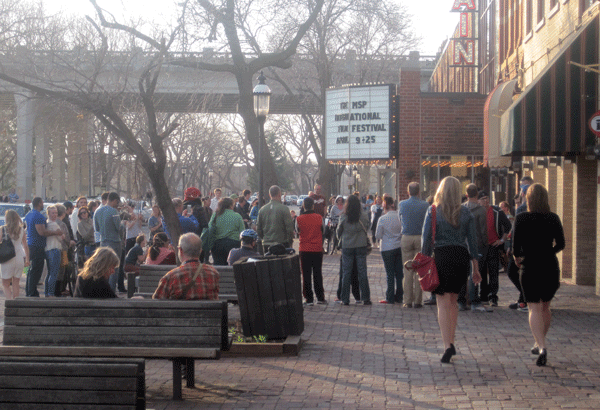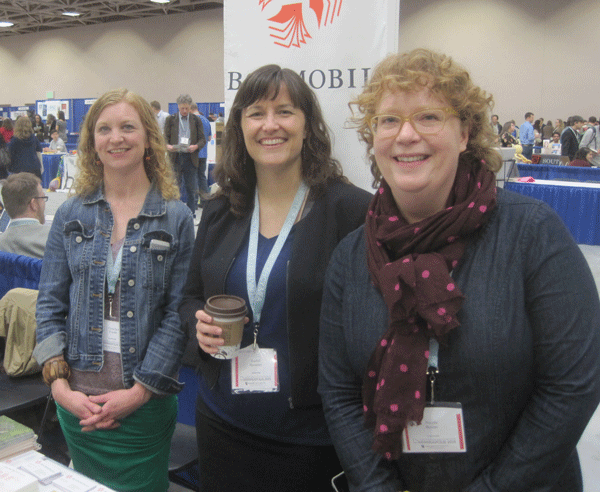The Minneapolis film fest is a three-week event. But when the
leaves are opening on the trees you start saying to yourself, "I don't
really need to see any of these
films. No one else will ever see them. One is more or less like another."
That's when it's nice to get an email from a friend:
"I'm lined up for Magicarena,
Nowhere in Moravia, and 1001 Grams today, and am thinking about Grandad and El Critico tomorrow, and
possibly Tu Dors Nicole and Unlikely Heroes on Fri...if I don't
totally burn out before then ... I do have a ticket for Cowboys on Saturday night as well (gonna hafta take a nap before
that)."
My friend has some free time on his hands, and he's viewing
for two—his wife is off monitoring an election in Kazakhstan. I was inspired to
join him in his quest, and since that time I've added a few more films to my
list.
Theeb (United Arab Emirates)
The best film I saw at the fest, Theeb is a tale of a man, the son of a sheik, who agrees to lead a British
soldier across the wastes of Saudi Arabia along an old pilgrim trail, now
mostly used by bandits, in search of a well. The Arab doesn't know what the
soldier is up to, and perhaps doesn't like him much, but he's obliged by the
unspoken rules of hospitality to take on the assignment. Matters are made
considerably more difficult for him when his baby brother, Theeb, decides the
follow the little caravan out into the desert.
Theeb bears some
similarity to American westerns like 3:10
to Yuma and Ride the High Country,
where the countryside is magnificent, danger is always near at hand, the law is
nonexistent, and it's sometimes hard to tell friend from foe. But it's full of
plot twists and subtle reversals of fortune that elevate it above the genre (if
there is one). Meanwhile, the central role played by Theeb himself, who wants
to become a man but is out of his element among seasoned and sometimes devious adults,
further enriches the plot. In short, the film has a rock-solid storyline to go
with its astounding scenery.
This is one of those back-stage production documentaries
like Michael Jackson's This Is It.
But the venue is a Roman coliseum in Verona, and the piece being rehearsed in
Verdi's Aida. The elephants involved
are mechanical, and there are lots of other gizmos involved, too, including
scads of glowing orbs and plastic crocodiles slithering by on skateboards. A
few things catch fire backstage, rain and wind upset the proceedings. As usual
with such films, we seldom get to hear an entire aria being performed, much
less a complete scene. Nevertheless, all the razzle-dazzle is fun to watch.
Nowhere in Moravia (Czech Republic)
Alongside the deadpan tone of many Wes Anderson films, and
the Irish good cheer of Ballykissangel,
and the energy and genius for outlandish caricature of Amarcord, we have the drollery of the Czech school of comedy,
tinged with absurdist overtones and black humor, but also, at its best, capable
of developing a degree of existential momentum. Nowhere in Moravia may be taken
as a case in point.
It is never laugh-out-loud funny, but it maintains a
consistent tone of stolid indifference that never quite sinks into weary resignation.
The small cast of characters includes the barmaid, Maruna; the town's reluctant
mayor, two brothers who share a house (and a loony woman), a homeless man named
Stinky, a roofer and his young side-kick, and one or two other local laborers.
Most
of the men in town are interested in getting into Maruna's pants, and she's
very matter-of-fact and obliging for the most part. Maruna's chief distinction
is that she used to be a school-teacher and can speak German. She lives with
her mother and her sister, who's a nurse.
Nothing much happens during the film. The mayor tried to
shoot a stag. Roofs get repaired. People
drink. They also eat a lot of sausages and bread. The countryside looms. It's a
timeless world, where dreams have died and the villagers have learned to accept
their lot. The rabbit stew is good. Someone gets killed. People drink.
The Iron Ministry (China)
Shot with a hand-held digital camera, this film focuses on
feet and the trash under the seats on Chinese trains. We listen in on a few
conversations, but most of the time we're watching people sleep, buy snacks
from vendors moving down the aisle, butcher meat in the compartments between
the cars, and look out the windows at the passing countryside. The film took
two years to make, but it seems the footage could have been shot in a single
day. The soundtrack is very loud. It's a visceral experience—clickety-clack,
clickety-clack.
Betibu (Argentina)
Cut from the same cloth as Argentina's Oscar-winning The Secrets in Their Eyes, this film
follows the lives of a wizened journalist, a rookie crime reporter, and a
romance writer turned columnist as they investigate a murder at a posh country
club estate. At times their investigations more closely resemble Almadovar's Flower of My Secret than Curtis Hanson's
L.A. Confidential, but the plotline
will keep viewers guessing 'til the end, when the tension drops--and then gets
ratcheted up again.
Belle and Sebastian (France)
If you liked Heidi,
you'll probably like this film about a boy named Sebastian who's being raised
by his wise but hard-drinking grandpa in the French Alps during WWII. The local
shepherds are being terrorized by a savage beast that turns out to be a sweet,
mangy dog whom Sebastian names Belle. There are a few subplots involving the
local doctor who guides fugitives across the mountain passes, the German soldiers
stationed in town to catch those fugitives, and Sebastian's young aunt
Josephine, who's in love with the doctor—though the German commander also seems
to be in love with her. The film has three drippy songs that might easily have
been removed, and it's hard to escape the fact it was made for children, but
the Alpine scenery is spectacular, the chase scenes are gripping, and the
crusty peasant sentiments are noble. (I cried.)
Papusza (Poland)
Did the Polish film industry run out of color film, or what?
First Ida, and now Papusza. Not that I'm complaining. Papusza tells the story of the gypsy
poetess of that name and the gadja
(i.e. non-gypsy) who comes to live with the band, recognizes Papusza's talent,
and later shares her poetry with the wider world.
The film is rich in long-shots of campfires by the river in the moonlight, caravans slowly crossing fields of stubble, and riotous parties at which the gypsy musicians have been invited to play. But if the cinematography romanticizes Roma lifeways to a degree, the plot-line exposes their patriarchic cruelty and xenophobia. Things do not end well for Papusza. Her big mistake was to learn how to read and write.
The film is rich in long-shots of campfires by the river in the moonlight, caravans slowly crossing fields of stubble, and riotous parties at which the gypsy musicians have been invited to play. But if the cinematography romanticizes Roma lifeways to a degree, the plot-line exposes their patriarchic cruelty and xenophobia. Things do not end well for Papusza. Her big mistake was to learn how to read and write.
Unlikely Heroes (Switzerland)
We return to the Alps for Unlikely Heroes, a film that deserves close scrutiny. Its central
character is a Swiss housewife named Sabine. Recently separated from her
husband, Sabine works as an assistant to a condescending psychotherapist who
has decided to exclude her from a long-standing Christmas event with their
mutual friends.
Following a chain of freak events too complicated and
fortuitous to describe, Sabine finds herself leading dramatic therapy sessions
with a group of asylum-seekers from Zimbabwe, Turkey, SE Asia, and other
unnamed parts of the world. These likeable but generally hapless individuals
hardly speak German and have no idea what therapy is, but they perk up when
Sabine begins to describe the story of William Tell, who is the classic hero of
Swiss self-identity. She brings Tell up merely as an example of a national
myth, hoping her students will chose stories from their own countries to act
out, but before long they've decided to stage Schiller's famous play.
The poignancy of this should be clear. Although the asylum-seekers
don't fit into modern-day Swiss society very well, they respond immediately to
a tale involving escape, heroism, and resistance to arbitrary authority. That
was Switzerland—a thousand years ago.
Much of the pleasure of watching Unlikely Heroes lies in the sweet dispositions, humorous lack of comprehension,
naive enthusiasms, and petty squabbles of the asylum-seekers. But I would give Esther
Gemsch, who plays Sabine, my vote for Best Actress of the festival. Her
portrayal of an intelligent woman who chose to raise a family and paid the
price by being abandoned by everyone, and is now floundering through an unexpected
flurry of creativity and renown, still questioning her talent and her motives, is
priceless.
The film has been criticized for giving a sugar-coated and unrealistic rendering of the problems that refuges seeking political asylum in Europe face. That's like saying Hogan's Heroes gives a false impression of life in a concentration camp. Unlikely Heroes is a morality tale and an inspirational journey. It chooses its themes carefully and develops them well.
The play turns out pretty good too. (I cried.)

The play turns out pretty good too. (I cried.)

Dukhtar (Pakistan)
I have never been to Kashmir, and I doubt if I will ever go
there. So I was glad to see the fantastic scenery of Dukhtar. (The growling, machine-gun-toting clansmen I could do
without.)
The story revolves around a young girl (maybe twelve?) who
is to be married off to a clan-lord to patch up a long-running feud. The girl
escapes with her mother, though there are not many places an unchaperoned
woman can escape to in Kashmir...
* * *
To be able to travel so widely without leaving town is a real treat. And we often extended the experience after a film by hunting up more information back home. After seeing Theeb, for example, I pulled my copy of The Arab of the Desert by H. R. P. Dickson (1949) off the shelf, and also Desert Tracings: Six Classic Arabian Odes by Alqama, Shanfara, Labid, Antara, etc.
Home from Pabusza, I scoured The Faber Book of Modern European Poetry, but she was not among those anthologized. I thought I might have better luck with Contemporary East European Poetry, (expanded edition, 1993) but once again, no. During my futile search I at least had the pleasure of listening to a long-neglected CD by the preeminent Romanian gypsy band, Taraf de Haidouks.
* * *
To be able to travel so widely without leaving town is a real treat. And we often extended the experience after a film by hunting up more information back home. After seeing Theeb, for example, I pulled my copy of The Arab of the Desert by H. R. P. Dickson (1949) off the shelf, and also Desert Tracings: Six Classic Arabian Odes by Alqama, Shanfara, Labid, Antara, etc.
Home from Pabusza, I scoured The Faber Book of Modern European Poetry, but she was not among those anthologized. I thought I might have better luck with Contemporary East European Poetry, (expanded edition, 1993) but once again, no. During my futile search I at least had the pleasure of listening to a long-neglected CD by the preeminent Romanian gypsy band, Taraf de Haidouks.
















































